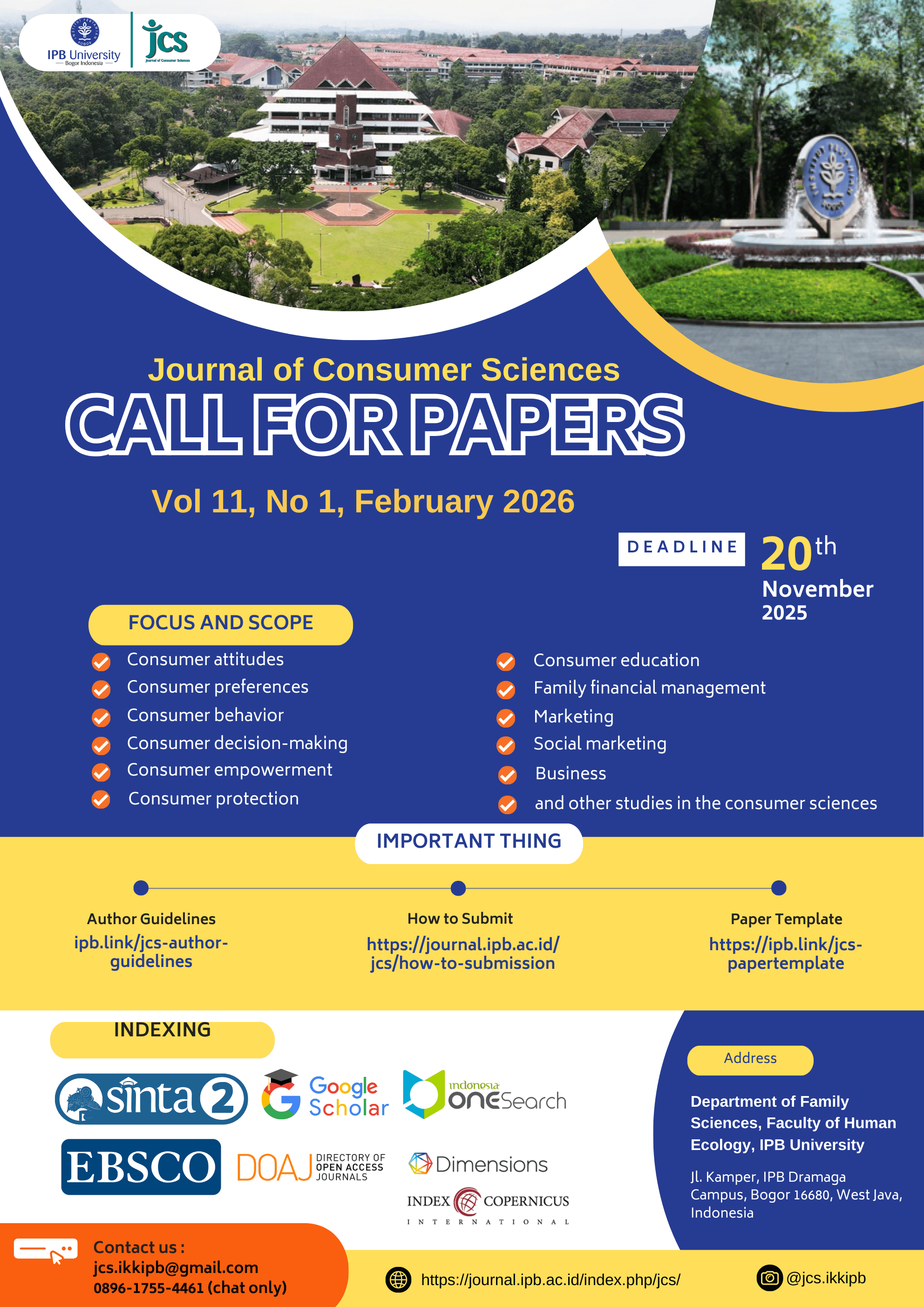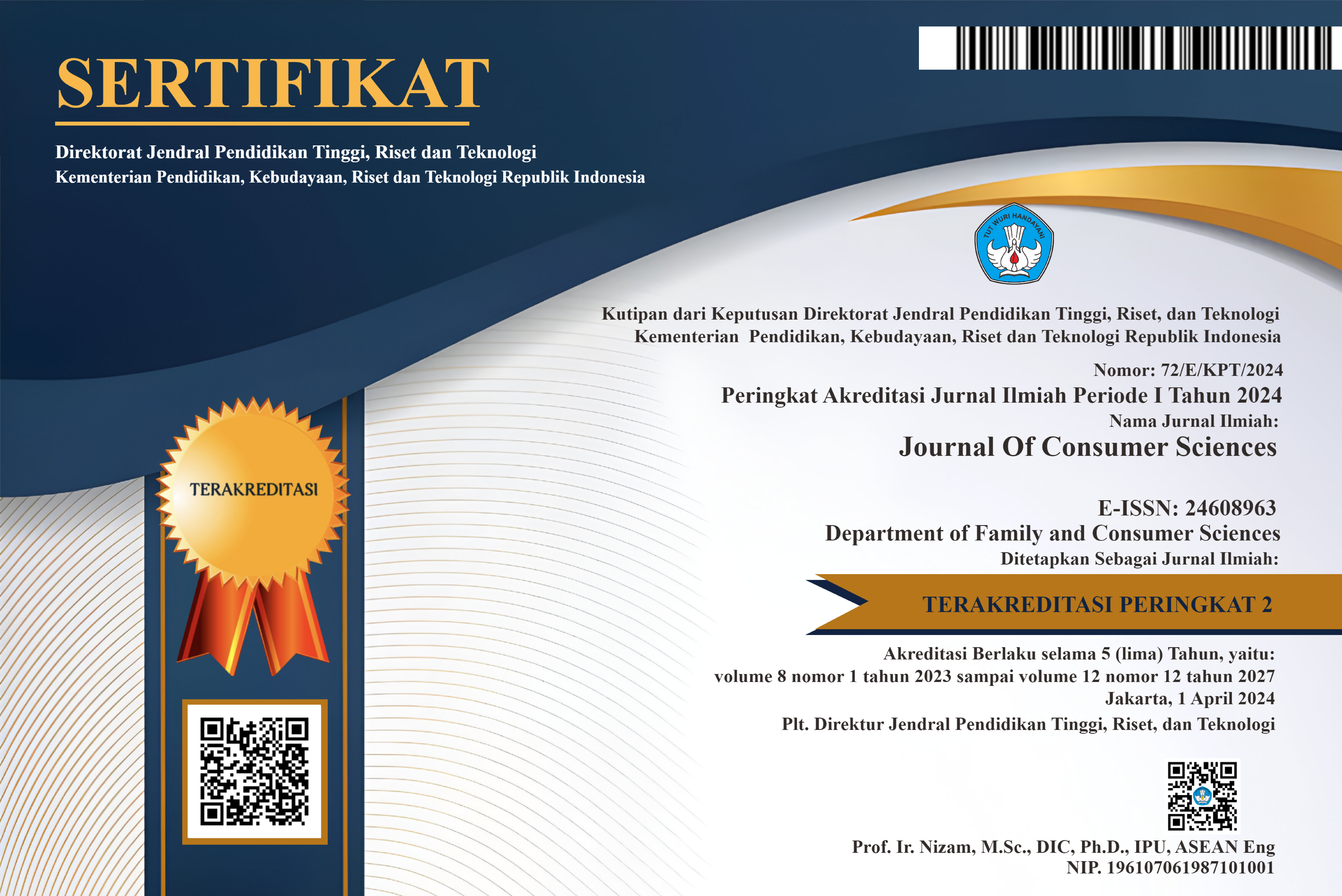Understanding Omnichannel Shopping Behaviors: Incorporating Channel Integration into The Theory of Reasoned Action
DOI:
https://doi.org/10.29244/jcs.8.1.15-26Keywords:
channel consistency, channel integration, omnichannel shopping, channel seamlessness, theory of reasoned actionAbstract
Young consumers prefer to switch shopping channels freely for optimal shopping results and experiences. To meet these changing needs, retailers have begun implementing an omnichannel retail strategy that integrates their various shopping channels to create a consistent and seamless shopping environment. Thus, this study examines the effect of young consumers' perceptions of the retailer's channel consistency and seamlessness on their attitudes, intentions, and behaviors in the omnichannel retailing context. We incorporated the concept of channel consistency and seamlessness into the Theory of Reasoned Action to address the study objective. A consumer research firm was hired to recruit millennials and Gen Z consumers, and online surveys took place in the U.S. in 2019, and 430 usable surveys were analyzed with SPSS and AMOS. The results confirmed that consumers’ perception of channel seamlessness positively impacted their attitudes toward omnichannel shopping. Furthermore, these attitudes and subjective norms increased their intentions, leading to engagement in omnichannel shopping. The findings suggest that retailers must create smooth and uninterrupted shopping experiences across channels and proactively manage social components to create a customer’s omnichannel shopping experience
References
Prediction and Change of Health Behavior: Applying The Reasoned Action Approach. Mahwah (US): Lawrence Erlbaum Associates Publishers.
Ashokkumar, J., & Nagarajan, P. S. (2021). Predicting intention to choose e-shopping using theory of reasoned action subjective to Covid-19 pandemic. Academy of Marketing Studies Journal, 25(4), 1-15.
Baykal, B. (2021). Managing customer Experiences in an Omnichannel World: Melody of Online and Offline Environments in The Customer Journey. Bingley (UK): Emerald Publishing Limited.
Belleau, B. D., Summers, T. A., Xu, Y., & Pinel, R. (2007). Theory of reasoned action: Purchase intention of young consumers. Clothing & Textiles Research Journal, 25(3), 244-257. https://doi.org/10.1177/0887302X07302768
Berman, B., & Thelen, S. (2018). Planning and implementing an effective omnichannel marketing program. International Journal of Retail & Distribution Management, 46(7), 598-614. https://doi.org/10.1108/IJRDM-08-2016-0131
Chen, Y., & Chi, T. (2021). How does channel integration affect consumers’ selection of omni-channel shopping methods? An empirical study of US. consumers. Sustainability, 13(16), 8983. https://doi.org/10.3390/su13168983.
Cheung, J., Glass, S., & Wong, C. (2017). Uniquely Generation Z: What brands should know about today’s youngest consumers. IBM Institute for Business Value. Retrieved from https://www.generationy20.com/retail-generation-z.PDF.
Cheung, J., Glass, S., Haller, K., & Wong, C (2018). What do Gen Z shoppers really want? IBM Institute for Business Value. Retrieved from https://nrf.com/research/what-do-gen-z-shoppers-really-want.
Chopdar, P. K., Korfiatis, N., Sivakumar, V. J., & Lytras, M. D. (2018). Mobile shopping apps adoption and perceived risks: A cross-country perspective utilizing the unified theory of acceptance and use of technology. Computers in Human Behavior, 86, 109-128. https://doi.org/10.1016/j.chb.2018.04.017
Copeland, L. R., & Zhao, L. (2020). Instagram and theory of reasoned action: US consumers influence of peers online and purchase intention. International Journal of Fashion Design, Technology and Education, 13(3). 265-279. https://doi.org/10.1080/17543266.2020.1783374
Donnelly, C. & Scaff, R. (2013). Who are the Millennial shoppers and what do they really want? Accenture. Retrieved from https://www.accenture.com/ca- en/insight-outlook-who-are-millennial-shoppers-what-do-they-really-want-retail
Evans, K. R., Christiansen, T., & Gill, J. D. (1996). The impact of social influence and role expectations on shopping center patronage intentions. Journal of the Academy of Marketing Science, 24(3), 208–218.
Fishbein, M. (1967). Readings in Attitude Theory and Measurement. New York(US): John Wiley & Sons.
Fishbein, M. A., & Ajzen, I. (1975). Belief, Attitude, Intention And Behavior: An Introduction to Theory and Research. Reading, MA(US): Addison-Wesley.
Gasparin, I., Panina, E., Becker, L., Yrjölä, M., Jaakkola, E., & Pizzutti, C. (2022). Challenging the “integration imperative”: A customer perspective on omnichannel journeys. Journal of Retailing and Consumer Services, 64, 102829. https://doi.org/10.1016/j.jretconser.2021.102829
Huang, J., Chang, C., & Chen, C. Y (2005). Perceived fairness of pricing on the Internet. Journal of Economic Psychology, 26(3), 343-361. https://doi.org/10.1016/j.joep.2004.03.002
Hermanda, A., Sumarwan, U., & Tinaprilla, D. N. (2019). The effect of social media influencer on brand image, self-concept, and purchase intention. Journal of Consumer Sciences, 4(2), 76-89. https://doi.org/10.29244/jcs.4.2.76-89
Huré, E., Picot-Coupey, K., & Ackermann, C.-L. (2017). Understanding omni-channel shopping value: A mixed-method study. Journal of Retailing and Consumer Services, 39, 314-330. https://doi.org/10.1016/j.jretconser.2017.08.011
Jang, J. Y. (September 23, 2021). Secrets of the Gen MZ. Korea JoongAng Daily. Retrieved from https://koreajoongangdaily.joins.com/2021/09/23/opinion/fountain/Generation-MZ-Generation-MZ-voters/20210923190240759.html
Kasasa. (2019). Boomers, gen X, gen Y, and gen Z explained. Retrieved from https://www.kasasa.com/articles/generations/gen-x-gen-y-gen-z
Kim, Y., Kim, E. Y., & Kumar, S. (2003). Testing the behavioral intentions model of online shopping for clothing. Clothing and Textiles Research Journal, 21(1), 32-40. https://doi.org/10.1177/0887302X0302100104
Kumar, S., Gupta, K., Kumar, A., Singh, A., & Singh, R. K. (2022). Applying the theory of reasoned action to examine consumers’ attitude and willingness to purchase organic foods. International Journal of Consumer Studies, 47(1), 12812. https://doi.org/10.1111/ijcs.12812
Kwon, W. S., & Lennon, S. J. (2007). Reciprocal effects between multichannel retailers’ offline and online brand images. Journal of Retailing, 85(3), 376-390. https://doi.org/10.1016/j.jretai.2009.05.011
Lawry, C. A., & Bhappu, A. D. (2021). Measuring consumer engagement in omnichannel retailing: The mobile in-store experience (MIX) index. Frontiers in Psychology, 12, 1-12. https://doi.org/10.3389/ fpsyg.2021.661503
Lim, Y. J., Osman, A., Salahuddin, S. N., Romle, A.R., Abdullah, S. (2016). Factors influencing online shopping behavior: The mediating role of purchase intention. Procedia Economics and Finance, 35(5), 401-410. https://doi.org/10.1016/S2212-5671(16)00050-2
Prayidyaningrum, S., & Djamaludin, M. (2016). Theory of planned behavior to analyze the intention to use the electronic money. Journal of Consumer Sciences, 1(2), 1-12. https://doi.org/10.29244/jcs.1.2.1-12
Park, J., & Kim, R. B. (2021). The effects of integrated information & service, institutional mechanism and need for cognition (NFC) on consumer omnichannel adoption behavior. Asia Pacific Journal of Marketing and Logistics, 33(6), 1386-1414. https://doi.org/10.1108/APJML-06-2018-0209
Pascual-Miguel, F. J., Agudo-Peregrina, Á. F., & Chaparro-Peláez, J. (2015). Influences of gender and product type on online purchasing. Journal of Business Research, 68(7), 1550-1556. https://doi.org/10.1016/j.jbusres.2015.01.050
Patrício, I, Fisk, R. F., Falcão e Cunha, J., & Constantine, L. (2011). Multilevel service design: From customer value constellation to service experience blueprinting. Journal of Service Research, 14(2), 180-200. https://doi.org/10.1177/1094670511401901
Picot-Coupey, K., Huré, E., & Piveteau, L. (2016). Channel design to enrich customers’ shopping experiences: Synchronizing clicks with bricks in an omni-channel perspectives–the Direct Optic case. International Journal of Retail & Distribution Management, 44(3), 336-368. Doi:10.1108/IJRDM-04-2015-0056
Pookulangara, S., Hawley, J., & Xiao, G. (2011). Explaining multi-channel consumer’s channel-migration intention using theory of reasoned action. International Journal of Retail & Distribution Management, 39(3), 183–202. Doi:10.1108/09590551111115024
Ryu, J. S. (2019). Consumer characteristics and shopping for fashion in the omni-channel retail environment. Journal of Business, Economics and Environmental Studies, 9(4), 15-22. https://doi.org/10.13106/jbees.2019.vol9.no4.15
Ryu, J. S., & Fortenberry, S. (2021). Performance expectancy and effort expectancy in omnichannel retailing. Journal of Industrial Distribution and Business, 12(4), 27-34. http://dx.doi.org/10.13106/jidb.2021.vol12.no4.27
Saghiri, S., Wilding, R., Mena, C., & Bourlakis, M. (2017). Toward a three-dimensional framework for omni-channel. Journal of Business Research, 77, 53-67. https://doi.org/10.1016/j.jbusres.2017.03.025
Seock, Y. K., & Norton, M. (2007). Attitude toward internet websites, online information search, and channel choices for purchasing. Journal of Fashion Marketing and Management, 11(4), 571-586. Doi:10.1108/13612020710824616
Sheeran, P. (2002). Intention-behavior relations: A conceptual and empirical review. European Review of Social Psychology, 12(1), 1-36. https://doi.org/10.1080/14792772143000003
Shetty, S., Jeevananda, S., & Kalghatgi, J. R. (2018). How to win back the disgruntled consumer? The omni-channel way. Journal of Business and Retail Management Research, 12(4), 200-207. Doi:10.24052/JBRMR/V12IS04/ART-20
Shi, S., Wang, Y., Chen, X., & Zhang, Q. (2020). Conceptualization of omnichannel customer experience and its impact on shopping intention: A mixed-method approach. International Journal of Information Management, 50, 325-336. https://doi.org/10.1016/j.ijinfomgt.2019.09.001
Silva, S. C. E., Martins, C. C., & de Sousa, J. M. (2018). Omnichannel approach: Factors affecting consumer acceptance. Journal of Marketing Channels, 25(1-2), 73-84. https://doi.org/10.1080/1046669X.2019.1647910
Sopadjieva, E., Dholakia, U. M. & Benjamin, B. (2017). A study of 46,000 shoppers show that omnichannel retailing works. Harvard Business Review. Retrieved from https://hbr.org/ 2017/01/a-study-of-46000-shoppers-shows-that-omnichannel-retailing-works.
Verhoef, P. C., Kannan, P. K., & Inman, J. J. (2015). From multi-channel retailing to omni-channel retailing: Introduction to the special issue on multi-channel retailing. Journal of Retailing. 91(2), 174-181. https://doi.org/10.1016/j.jretai.2015.02.005
Xu, X., & Jackson, J. E. (2019). Examining customer channel selection intention in the omni-channel retail environment. International Journal of Production Economics, 208, 434-445. https://doi.org/10.1016/j.ijpe.2018.12.009
Downloads
Published
Issue
Section
License
Authors who publish with this journal agree to the following terms:
- Authors retain copyright and grant the journal right of first publication with the work simultaneously licensed under a

This work is licensed under a Creative Commons Attribution 4.0 International License. that allows others to share the work with an acknowledgement of the work's authorship and initial publication in this journal. - Authors are able to enter into separate, additional contractual arrangements for the non-exclusive distribution of the journal's published version of the work (e.g., post it to an institutional repository or publish it in a book), with an acknowledgement of its initial publication in this journal.
- Authors are permitted and encouraged to post their work online (e.g., in institutional repositories or on their website) prior to and during the submission process, as it can lead to productive exchanges, as well as earlier and greater citation of published work (See The Effect of Open Access).

















